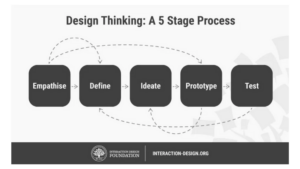Chapter 1: Design Thinking
Overview
Design thinking refers to the set of procedures used by designers to create solutions to resolve problems. It is often associated with the innovation of products and services within many workplace contexts. It is relevant to technology and leadership, because it will provide a framework for identifying needs, developing solutions, and the maintenance of those solutions over time. An idea is a valuable asset, but planning and protocols need to be structured prior to execution to verify the sustainability and long-term role the idea will have within the future of the organization. Solid leaders need to have these skills and hopefully, you will gain those skills from the course.
History
Watch the short video below from Harvard Business Review, which shares a brief history of design thinking and how it can be used to transform your leadership.
General Framework

There is a general framework for design thinking but above all else, remember design thinking is a human-centered design focus. Here are the elements of design thinking outlined by Berman (2019):
- The people come first.
 Assess the actual needs of your stakeholders. The people within your organization and possibly the people your organization serves will be affected by the choices. It is important to understand how users will interact with the technology proposed, as their potential interactions (or the lack of!) will likely fuel your eventual decision. Putting the people first goes beyond surveying users, it is also bringing relevant people to the conversation to throughout the process, rather than just at the beginning. The more invested your constituents are, the more successful the initiative!
Assess the actual needs of your stakeholders. The people within your organization and possibly the people your organization serves will be affected by the choices. It is important to understand how users will interact with the technology proposed, as their potential interactions (or the lack of!) will likely fuel your eventual decision. Putting the people first goes beyond surveying users, it is also bringing relevant people to the conversation to throughout the process, rather than just at the beginning. The more invested your constituents are, the more successful the initiative!
- Learn to fail successfully.
- The art of failing will be discussed in more detail in Chapter 6. However, the overview is failure does not inhibit success, it can often encourage greater successes when we are forced to pivot and overcome challenges. Design thinking will support a project, offering ways to fail without extensive costs. For example, prototyping a tool can help identify challenges as well as solutions before it is launched organization-wide.
- Brainstorming = Idea Generation
- Brainstorming is a common technique, to flex your creative muscles as you develop new strategies. Brainstorming, with the added benefit of the human-centered approach, will provide a means for all to contribute, giving a voice to those who may not have it otherwise.
- Creative thinking will invite new solutions.
- Once the mindset has shifted from “you cannot fail” to “you have the freedom to fail”, there are no limits to the solutions. The freedom and autonomy to creatively address challenges builds connection, increases confidence, and often leads to better results.
Relevance
Technology Tools for Leaders is going to show you the process of design thinking as you develop a program charter, budget, and progress report on a scenario of your choice. Then, you will work through other elements related to technology implementation including communication, failure, continuous improvement, and privacy concerns. You will investigate the technology needs for an organization and then prepare the organization’s members for changes in technology, while also developing the initiatives for technology changes which will maximize organizational effectiveness.
Exercises
Before we dive into some design thinking exercises, please remember these rules in relation to brainstorming:
- Defer judgment of all suggestions. Maintain an open mind; nothing is impossible (yet).
- Encourage unique, wild, and innovative ideas.
- Build on the ideas of others.
- While you want to encourage all the ideas, stay focused on the specific initiative.
- Everyone should be respectful in their communication; one person should speak at a time to ensure everyone is heard.
- Offer visuals such as a white board if in person or Google Jam Boards if you are virtual.
- No idea is a bad idea: Track all ideas, high quantities of ideas are expected!
Supplementary Resources
- How can design thinking help us?
- What is design thinking?
- Health Design Thinking: An innovative approach in public health to define problems and find solutions
- The core of design thinking and its application
- Research on interdisciplinary design thinking and methods based on programmable mechanical metamaterials
- An introduction to design thinking and an application to the challenges of frail, older adults
- Design thinking
- Put design thinking into practice with the open practice library
References
Berman, E. (2019). Your technology outreach adventure. American Library Association.
Harvard Business Review (2020). What is design thinking? [Video]. YouTube. https://www.youtube.com/watch?v=_WI3B54m6SU


